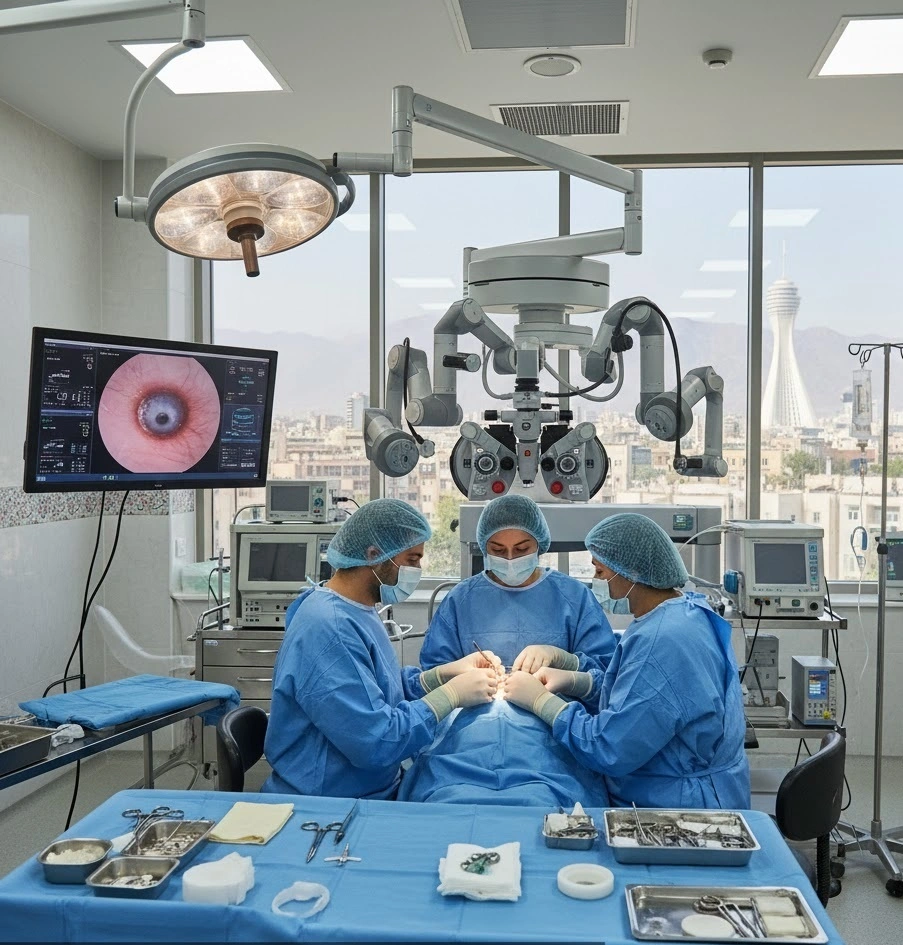
A cataract is a clouding of the eye’s natural lens, which can lead to blurred vision, glare, and difficulty seeing clearly. It is a common condition, especially in people over the age of 50, and can significantly affect daily activities like reading, driving, or recognizing faces.
When lifestyle or vision quality is impacted, cataract surgery becomes necessary. This procedure replaces the cloudy lens with an artificial intraocular lens (IOL), restoring clear vision and improving quality of life.
Common signs that indicate the need for cataract surgery include:
Gradual blurring of vision that interferes with daily tasks
Sensitivity to bright lights or glare, especially at night
Difficulty distinguishing colors or seeing contrasts
Frequent changes in eyeglass prescription without improvement
For international patients, choosing cataract surgery in Iran offers access to advanced surgical techniques, experienced ophthalmologists, and affordable medical tourism options, making it a safe and cost-effective solution for restoring clear vision.

Advances in ophthalmology have made cataract surgery in Iran safer, faster, and more precise than ever. Modern techniques allow surgeons to restore clear vision with minimal discomfort and short recovery times. Here are the most widely used methods:
Phacoemulsification, often called Phaco, is the most common cataract surgery technique worldwide. In this method:
A small incision is made in the cornea.
An ultrasonic device breaks up the cloudy lens into tiny pieces.
The lens fragments are gently removed, and an artificial intraocular lens (IOL) is inserted.
Advantages:
Minimally invasive, requiring only a tiny incision
Fast recovery, usually within a few days
Reduced risk of complications compared to older methods
Recovery: Most patients notice improved vision within 24–48 hours and can return to normal daily activities quickly.
Femtosecond laser-assisted cataract surgery uses a laser to perform precise steps of the procedure that were previously done manually.
Differences from conventional Phaco:
Laser creates exact corneal incisions and softens the lens for easier removal
Increases precision, potentially reducing risk of complications
May improve visual outcomes, especially for patients with higher prescriptions or complex cataracts
Advantages:
Ultra-precise lens fragmentation and incision
Shorter ultrasound energy needed, which can reduce stress on the eye
Enhanced safety and predictability
After removing the cloudy lens, a surgeon replaces it with an intraocular lens (IOL). Several types are available:
Monofocal IOLs – Provide clear distance vision; glasses may still be needed for reading
Multifocal IOLs – Offer clear vision at multiple distances, reducing dependency on glasses
Toric IOLs – Correct astigmatism along with cataracts
Choosing the right lens:
Depends on your visual needs, lifestyle, and eye condition
Experienced surgeons in Iran help patients select the lens that best matches their daily activities and expectations
For international patients, choosing cataract surgery in Iran not only provides access to these advanced techniques but also combines expert care with affordable medical tourism options.
Proper preparation is essential for a safe and successful cataract surgery in Iran. Taking the time for thorough preoperative evaluation helps ensure the best possible visual outcomes and minimizes potential risks.
Before undergoing cataract surgery, several essential tests are completed to assess eye health and determine the most suitable surgical approach:
These evaluations are performed using modern diagnostic equipment by experienced ophthalmologists, ensuring both safety and accuracy.
The consultation is your opportunity to finalize your treatment plan. The surgeon will discuss:
✨
Proper preparation not only improves surgical results but also gives patients peace of mind, helping them feel confident about their decision to undergo cataract surgery.
Understanding what to expect during cataract surgery in Iran helps patients feel prepared and confident. Modern techniques make the procedure safe, quick, and highly effective.
Cataract surgery is typically an outpatient procedure performed under local anesthesia using numbing eye drops. The step-by-step process usually includes:
Prepping the Eye: The eye is cleaned, and a speculum gently holds the eyelids open.
Incision: A tiny incision is made in the cornea, often less than 3 mm.
Lens Removal: The cloudy lens is broken into small pieces using ultrasound (Phaco) or softened with femtosecond laser, then carefully removed.
Intraocular Lens (IOL) Placement: A new artificial lens is inserted to replace the natural lens.
Closing the Incision: In most cases, the incision is self-sealing and does not require stitches.
Throughout the surgery, patients may feel slight pressure but typically do not experience pain. Surgeons using advanced equipment ensure precision and safety at every step.
Duration: The entire procedure usually takes 15–30 minutes per eye, making it quick and efficient.
Immediate Recovery: Most patients notice improved vision within 24–48 hours, though some mild blurriness or glare may occur initially.
Returning to Daily Activities: Patients can resume normal activities within a few days, avoiding strenuous exercise for about a week.
Follow-Up: Surgeons schedule follow-up appointments to monitor healing and ensure optimal visual outcomes.
For international patients, cataract surgery in Iran combines short recovery times with expert postoperative care, making it convenient for medical tourists seeking safe and effective vision restoration.
For many patients, understanding the cost of cataract surgery in Iran is an important factor when planning treatment. Iran offers high-quality care at a fraction of the price compared to many Western countries, making it an attractive destination for affordable and advanced cataract treatment.
These prices make cataract surgery in Iran a cost-effective option, especially for international patients seeking modern techniques with experienced surgeons.
Typical packages for cataract surgery in Iran usually cover:
Some additional costs may include accommodation, transportation, and optional concierge services for international patients.
Iran is a growing hub for medical tourism. Many clinics offer comprehensive packages that include:
Choosing cataract surgery in Iran allows patients to access world-class surgical care, lower costs, and personalized medical tourism support.
While cataract surgery in Iran is generally safe and highly effective, it’s important for patients to understand the potential risks, temporary side effects, and realistic outcomes before undergoing the procedure. Being informed helps set proper expectations and ensures a smooth recovery.
After cataract surgery, most patients experience mild and temporary effects that usually resolve within a few days to weeks:
Dry eyes: Mild irritation or dryness is common and can be managed with prescribed eye drops.
Blurred or fluctuating vision: Vision may be slightly blurry immediately after surgery before stabilizing.
Light sensitivity or glare: Some patients notice increased sensitivity to bright light or glare at night, which generally improves with time.
These temporary effects are normal and part of the eye’s natural healing process.
Serious complications are uncommon but can occur, even with advanced techniques:
Infection (endophthalmitis): Rare but treatable with antibiotics
Lens dislocation or misplacement: Occasionally the intraocular lens may shift, requiring adjustment or replacement
Need for reoperation: Some patients may require minor additional procedures if residual refractive error remains
Choosing experienced surgeons and reputable centers, such as Bina Hospital in Mashhad, significantly reduces the likelihood of these complications.
Improved vision is likely, but not always perfect: Most patients achieve excellent distance vision, but reading glasses may still be needed for close work depending on the type of IOL.
Recovery is gradual: Visual clarity may continue improving for a few weeks after surgery.
Aging factors: Natural eye changes like presbyopia or cataract in the other eye can affect long-term vision.
Understanding the realistic outcomes of cataract surgery in Iran helps patients feel confident, prepared, and satisfied with their results.

Patients who undergo cataract surgery in Iran can expect long-lasting improvements in vision, but understanding the factors that influence long-term results helps set realistic expectations.
For most patients, clear vision is achieved immediately after surgery and remains stable for many years.
Modern intraocular lenses (IOLs) and precise surgical techniques help maintain visual clarity for 10–20 years or more.
Minor changes in vision may occur naturally over time, but most patients remain largely independent of glasses for distance vision.
Aging can gradually affect vision, even after successful cataract surgery. Around the age of 40–45, patients may experience presbyopia, requiring reading glasses for near tasks.
Some patients might need minor enhancements or adjustments if residual refractive error develops, though this is relatively uncommon.
Choosing experienced surgeons and advanced techniques in Iran ensures that any future adjustments are easier and safer to perform.
By understanding these factors, patients can confidently choose cataract surgery in Iran, knowing they are investing in a long-term solution for clearer vision and improved quality of life.
If you are ready to experience the benefits of cataract surgery in Iran, our medical tourism platform makes the process simple, safe, and fully guided. We connect international patients with trusted hospitals, experienced surgeons, and comprehensive care packages.
1. Request a Free Medical Evaluation: Submit your initial eye health information through our secure online form. We determine if you are a suitable candidate for cataract surgery in Iran.
2. Upload Your Medical Reports: Easily share your test results and prescription details. This allows our partnered ophthalmologists to plan your personalized treatment in advance.
3. Schedule an Online Consultation: Speak directly with experienced surgeons (e.g., from Bina Hospital in Mashhad). Discuss your lens choices and expected outcomes before traveling.
4. Compare Hospitals and Surgeons: Review different hospitals, surgical teams, and treatment packages through our platform to find the best fit for your needs.
By choosing our services, you not only gain access to world-class cataract surgery in Iran, but also enjoy a guided medical tourism experience—from travel planning to post-operative care. Let us help you achieve clearer vision with comfort and confidence.
A: Cataract surgery removes the cloudy natural lens of the eye and replaces it with an artificial intraocular lens (IOL). This restores clear vision and improves overall visual quality. In Iran, advanced techniques like Phacoemulsification and Femtosecond laser-assisted surgery are widely available.
A: Ideal candidates are adults with vision impairment due to cataracts, healthy eyes, and no contraindicating medical conditions. Preoperative evaluation ensures your eye health, lens selection, and surgical technique are personalized for optimal results.
A: No. Local anesthesia via numbing eye drops is used, and patients typically feel minimal discomfort. Most describe a slight pressure or mild irritation, which is manageable and temporary.
A: The procedure usually takes 15–30 minutes per eye. Most patients notice improved vision within 24–48 hours, and normal activities can resume within a few days. Complete stabilization of vision may take a few weeks.
A: Common temporary effects include dry eyes, mild glare, or blurry vision. Rare complications may include infection, lens displacement, or the need for minor additional procedures. Choosing experienced surgeons and reputable hospitals, such as Bina Hospital in Mashhad, reduces these risks significantly.
A: Modern cataract surgery provides long-lasting vision improvements, often stable for 10–20 years or more. Aging may gradually affect near vision (presbyopia), and minor enhancements may occasionally be needed.
A: Common options include:
Monofocal IOLs: Clear distance vision; reading glasses may still be needed
Multifocal IOLs: Clear vision at multiple distances, reducing dependence on glasses
Toric IOLs: Correct astigmatism along with cataracts
Experienced surgeons in Iran help patients select the lens that best fits their lifestyle.
A: Costs vary based on technique, lens type, and hospital, but prices in Iran are often significantly lower than in the USA or Europe. Packages typically include preoperative tests, surgery, lens implantation, medications, and follow-up visits.
A: Absolutely. Iran is a growing destination for medical tourism. Our platform helps patients with travel arrangements, visas, accommodation, and connects them with trusted hospitals and surgeons, ensuring a safe and convenient experience.
A: You can:
Request a free medical evaluation online
Upload your medical reports securely
Schedule an online consultation with an experienced surgeon
Compare hospitals and treatment packages to choose the best fit
Our medical tourism service guides you through every step, ensuring a comfortable and well-organized experience.